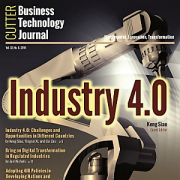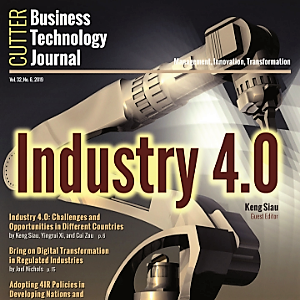Industry 4.0, also known as the Fourth Industrial Revolution (4IR), refers to the current technology period enabled by advanced technologies, such as artificial intelligence (AI), machine learning (ML), big data, the Internet of Things (IoT), cyber-physical systems (CPSs), robotics, and automation. Although some researchers use Industry 4.0 in a more restricted sense, defining Industry 4.0 as a subset of 4IR, in this issue, we take the broader view and use Industry 4.0 and 4IR synonymously.
Embracing Industry 4.0 has become an important source of competitive advantage as enterprises incorporate advanced technologies like AI, ML, IoT, CPSs, robotics, and automation into strategic plans, manufacturing and factory operations, and business procedures. New business models are sprouting up through digitization and automation of products and services. Industry 4.0 will have a disruptive and transformative impact on the economy, business, jobs, and society.
Many predict that Industry 4.0 will be different from the first three industrial revolutions because of its disruptive and transformative impact on the nature of work and the future of society.1 The way we work, the way we are trained, the way we are educated, the way we play, and the way we live will all be altered and transformed.
The first industrial revolution spanned from the end of the 18th century to the beginning of the 19th century. The invention of the steam engine and the emergence of mechanization established the role of industry as the foundation of the economic structure, accelerating the development of the economy and society.
Nearly a century later, from the 1870s onward, the emergence and expansion of electricity, gas, and oil represented the beginning of the second industrial revolution. The steel industry began to develop. Chemical synthesis provided us with synthetic fabric, dyes, and fertilizer. The telegraph and telephone were invented, revolutionizing the way we communicate. The second industrial revolution also enabled the emergence of “large factories” and the economy of scale made possible by mass production.
In the second half of the 20th century, the third industrial revolution appeared with the emergence of a new type of energy (i.e., nuclear energy), the rise of electronics (i.e., transistors and microprocessors), and the development of information technology. This revolution gave rise to the era of high-level automation in production thanks to two major inventions: automatons (programmable logic controllers [PLCs]) and robots.
Today, a fourth industrial revolution is unfolding before our eyes. Industry 4.0 builds upon the third industrial revolution and the digital revolution that has been taking place since the middle of the last century. Industry 4.0 will blur the lines between physical, digital, and biological spheres, enabling us to build a new virtual world from which we can steer the physical world. Technology, such as cloud computing, big data, and the IoT, enables us to connect all production means and allows them to interact in real time. Low-cost gene sequencing and techniques such as CRISPR (clustered regularly interspaced short palindromic repeats) massively expand our ability to edit the building blocks of life. AI is augmenting processes and skill in every industry, from self-driving cars and drones to virtual assistants like Siri and Google Home. Neurotechnology is making unprecedented strides in helping us understand cognition and enabling us to better utilize and influence the brain. AI and automation are disrupting century-old transport and manufacturing paradigms. The extent and depth of these changes will transform manufacturing, production, management, and governance systems on a global scale. These changes are transforming how we communicate, learn, entertain ourselves, and relate to one another and help us better understand ourselves as human beings.
On one hand, Industry 4.0 promises great benefits and advantages. New technologies are being developed and implemented at an accelerated pace. Indeed, the speed of current breakthroughs has no historical precedent.2 Industry 4.0 can provide us with much more rewarding and fulfilling lives. On the other hand, our responsibilities to one another, our opportunities for self-realization and self-actualization, and our ability to positively impact our communities and the world are intricately tied to and shaped by how we engage with and manage the technologies of Industry 4.0. This revolution can yield greater inequality, especially in its potential to disrupt labor markets.3 As AI and robotics become more intelligent and can substitute for labor across the entire economy, the displacement of workers may exacerbate the gap between returns to capital and returns to labor.4
Of course, all previous industrial revolutions have had both positive and negative impacts on different stakeholders. By recognizing the risks, whether of cybersecurity threats, educational misfit, misinformation on a massive scale through digital media, potential unemployment and displacement, or increasing social and income inequality, we can take steps to manage technological progress and align technological advancements with humanity’s needs and values to ensure that Industry 4.0 places humanity first and foremost.
Industry 4.0 is much more than technology. It is an opportunity to unite global communities, reduce inequalities, build advanced economies, provide sustainable environments, and modernize governance and management models. Industry 4.0 is a call for action. Industry 4.0 can provide the impetus to develop, reengineer, and enhance our governing technologies in ways that foster a more empowering, collaborative, and sustainable foundation for social and economic development, built around ethical and moral values. We have a great opportunity to proactively shape Industry 4.0 to be both inclusive and human-centered. But we must integrate our response more fully by involving stakeholders from both the public and private sectors and embracing ideas from academia and industry.
In This Issue
This issue of Cutter Business Technology Journal examines the latest advancements in technologies related to Industry 4.0 and the impact of these technologies on work, business, and organizations. We feature six articles in this issue that cover a range of topics.
In the first article, Keng Siau, Yingrui Xi, and Cui Zou explore the challenges and opportunities that Industry 4.0 presents in four groups of countries: developed, newly industrialized, developing, and least-developed. Industry 4.0 will impact countries in these development stages differently. The article discusses the factors that will impact the development of Industry 4.0 and provides suggestions for countries to avoid the risks inherent in Industry 4.0 and capitalize on opportunities to develop their economies. The article is beneficial to business executives as they contemplate investment decisions related to Industry 4.0.
Next, Joel Nichols discusses the barriers and challenges facing regulated industries as they attempt to implement Industry 4.0 technologies and change their culture. The article examines the questions that regulated industries must address as they embrace digital transformation and the advances that specific Industry 4.0 technologies can yield. The author argues that although digital transformation may require more time in regulated than in nonregulated industries, “the impact of regulated industry transformation on producers and consumers alike ultimately will be greater than that of the nonregulated sector.”
Doug Hadden’s article focuses on the opportunities and threats for governments in developing countries and emerging economies. Governments in developed countries exhibit a sophisticated policy design, enabling them to better exploit Industry 4.0, while developing countries and emerging economies, which have lower government effectiveness and less-sophisticated manufacturing, face more obstacles to benefit from Industry 4.0. Hadden discusses the government and country context that must be considered when developing policy interventions to optimize the potential of 4IR while mitigating vulnerability. In this context, the author suggests that policymakers use a VUCA (volatility, uncertainty, complexity, and ambiguity) analysis to determine potential and vulnerability. He then recommends public policy interventions to maximize potential and reduce vulnerability.
Our fourth article, by Barry O’Reilly, explores whether a skills crisis arising out of Industry 4.0 truly exists. Although organizations perceive a skills crisis as Industry 4.0 makes software a central part of every business, O’Reilly notes that the IT industry has complained of a skills crisis for years. He examines what the skills shortage really is, discusses past approaches to the crisis, and evaluates whether those approaches have worked. He then proposes a new view of the skills crisis and suggests alternative approaches to solving it. O’Reilly sees critical thinking and a reassessment of our view of skills as key components of resolving the perceived skills crisis.
In our fifth article, Feng Xu and Xin (Robert) Luo argue that because Industry 4.0 leads to potential new cybersecurity risks to manufacturing and supply networks, cybersecurity management must protect industry assets. The authors examine the issues specific to Industry 4.0, the three conventional essential security requirements, present and discuss the challenges of the security management cycle in Industry 4.0, and offer recommendations for cybersecurity management in Industry 4.0.
In our concluding article, Weiyu Wang and Keng Siau address the ethical and moral predicaments that Industry 4.0 creates. They discuss Industry 4.0 ethical and moral issues from the perspective of different business-oriented forces — stakeholders and business executives, employees, customers/clients, society — and different technical-oriented forces — designers and developers, users, intelligent agents. Their framework in Industry 4.0 considers ethical issues related to data and ethical issues related to systems, technology products, and services. Their discussion will enable business executives and technical designers/developers to have a better understanding and appreciation of the ethical and moral challenges in Industry 4.0.
Industry 4.0
The six articles in this issue of Cutter Business Technology Journal examine the latest advancements in technologies related to Industry 4.0 and the impact of these technologies on work, business, and organizations. Available for purchase in the Cutter Bookstore. Save 20% with Coupon Code Industry4-20.
References
1Hyder, Zeshan, Keng Siau, and Fiona Nah. “Artificial Intelligence, Machine Learning, and Autonomous Technologies in Mining Industry.” Journal of Database Management, Vol. 30, No. 2, 2019; and Wang, Weiyu, and Keng Siau. “Artificial Intelligence, Machine Learning, Automation, Robotics, Future of Work, and Future of Humanity — A Review and Research Agenda.” Journal of Database Management, Vol. 30, No. 1, 2019.
2Siau, Keng, et al. “FinTech Empowerment: Data Science, Artificial Intelligence, and Machine Learning.” Cutter Business Technology Journal, Vol. 31, No. 11/12, 2018.
3Siau, Keng. “Education in the Age of Artificial Intelligence: How Will Technology Shape Learning?” The Global Analyst, Vol. 7, No. 3, March 2018.
4Siau, Keng, and Weiyu Wang. “Building Trust in Artificial Intelligence, Machine Learning, and Robotics.” Cutter Business Technology Journal, Vol. 31, No. 2, 2018.




